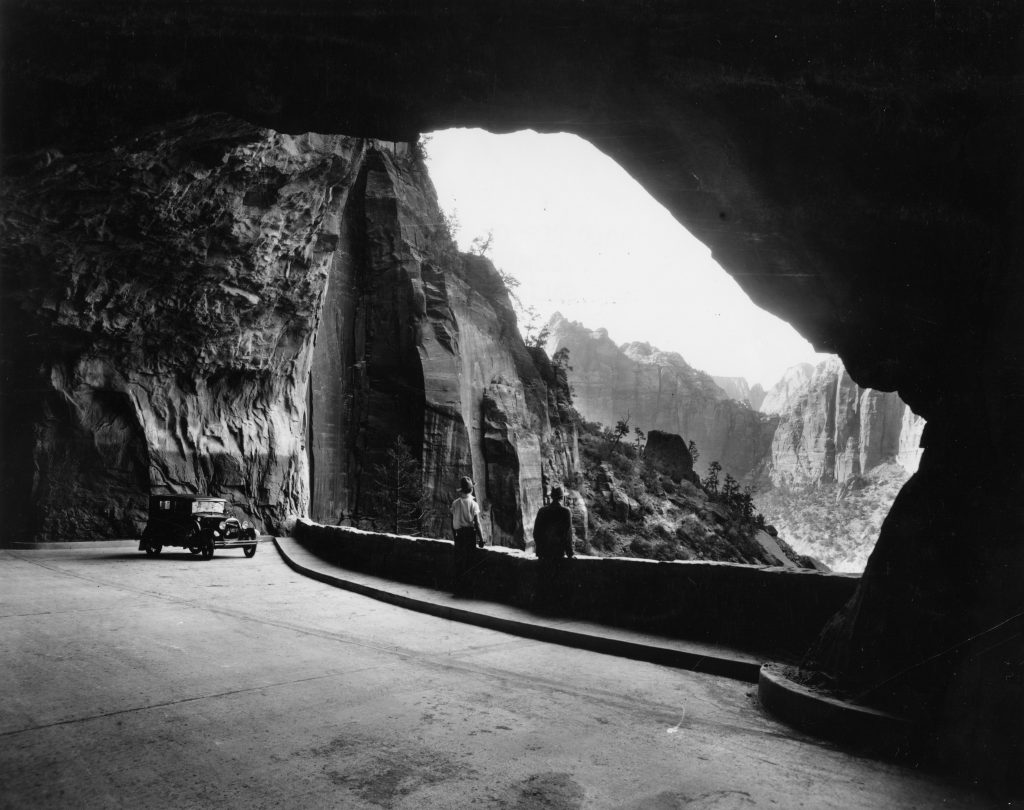ST. GEORGE — In the early 1900s, when the scenic Zion Mt. Carmel Highway and tunnel were created, vehicles were light and moved slowly.

Today, engineering and traffic studies regarding road use show a massive increase in both total usage and the weight of large vehicles, which can exceed legal requirements and present public safety concerns. As a result, Zion National Park and community leaders, along with other organizations, are discussing possible operational changes to the historic highway and tunnel.
Zion National Park Communications Specialist Ally O’Rullian told St. George News that in discussing potential operational changes, the park determined that expanding the historic road is not feasible because of the terrain.
“New construction would be prohibitively expensive and would significantly impact the park’s landscapes, plants, animals and affect the historic values of the road itself,” O’Rullian said. “The operational changes the park is proposing relate to large vehicles only and aim to take care of this historic road and its historic bridges, as well as reduce the likelihood of collisions for all visitors.
O’Rullian said the park will continue to inform the public about specific operational changes being considered as officials receive input from community leaders and stakeholders. Neighboring Springdale Mayor Barbara Bruno told St. George News in an email they appreciate the park inviting them to the discussions.
“I and other representatives of the town of Springdale have been included in conversations about the Zion-Mt. Carmel Highway and Tunnel. We support any solutions that improve driving conditions and reduce the likelihood of accidents and structural damage,” Bruno said. “We also appreciate being included early in the process so that we can inform our residents, business owners, and visitors as they plan their commutes and visits.”
Zion National Park Superintendent Jeff Bradybaugh said in an email to St. George News that park and community leaders need to coordinate efforts.
“We need to work together to protect drivers, meet safety parameters and ensure the integrity of the road and tunnels so that we continue to enjoy scenic drives on the historic Zion-Mt. Carmel Highway,” Bradybaugh said.

Discussions focus on potential operational changes on the Zion-Mt. Carmel Highway to meet safety requirements and to reduce the following
- Collision likelihood
- Overweight transits on road bridges
- Lane-crossing due to vehicles being too large and/or long to negotiate turns
In 1919, a Congressional bill designating Zion National Park was signed into law. At the time, there was no passage to the park’s east side. In 1923, a route was chosen that allowed travel on switchbacks up the side of Pine Creek Canyon, which needed a tunnel and then along Clear Creek to the east boundary of the park. Then, in 1927, construction began on the Zion-Mount Carmel Tunnel and the Zion-Mount Carmel Highway.
According to a news release, the tunnel was considered quite an engineering feat, requiring boring 5,613 feet through solid rock.
On July 4, 1930, the tunnel and highway were dedicated, linking Zion Canyon to the land east of the park and making it easier to visit the Grand Canyon and Bryce Canyon national parks.
Bradybaugh said that large vehicles like buses cross the centerline in 18 locations where the road’s turning radius cannot accommodate long vehicles which becomes problematic when they exceed 35 feet, 9 inches, on the roadway.
He added that weight is also a factor that may be damaging the road. Vehicles heavier than the 50,000-pound capacity are prohibited on the bridges.
Bradybaugh said there are also additional restrictions in the Zion-Mt. Carmel Tunnel. Vehicles wider than 7 feet, 10 inches, and taller than 11 feet, 4 inches, cannot pass through the tunnel while maintaining two-way traffic and require a tunnel escort. Vehicles taller than 13 feet, 1 inch, cannot pass through the tunnel and are prohibited.

The Zion-Mt. Carmel Highway is a landmark listed on the National Register of Historic Places. It is designated as a Historic Civil Engineering Landmark. The road was designed and constructed in the 1920s and 1930s. Bradybaugh noted that although the design elements make the road more compatible with the landscape, it’s more difficult for modern, larger vehicles to travel safely. To conform with the landscape, the road’s designers had to build:
- Tight turns.
- Some steep grades.
- A large number of switchbacks.
- Relatively narrow lanes.
- Two low and narrow tunnels.
- Bridges.
The tunnel passes through soft sandstone, according to the park’s website. Because of the softness of the sandstone, much reinforcing has been done, and concrete ribs now give added support to the tunnel’s entire length. “The collapse of a sandstone pillar west of Gallery No. 3 in 1958 broke the top out of that gallery and flushed tons of debris into the tunnel, causing its closure for several weeks. Because of that collapse, the tunnel is now monitored electronically 24 hours a day to warn park officials to the danger of a reoccurrence.”
To learn more about the Zion-Mt. Carmel Tunnel, visit the park’s website.
Photo Gallery

A park ranger helps with traffic on Zion-Mt Carmel Highway near the tunnel, Zion National Park, Utah, date not specified | Photo courtesy of the National Park Service, St. George News

Drivers of vehicles that are 11 feet, 4 inches tall or taller or 7 feet, 10 inches wide or wider, including mirrors, awnings, and jacks, require a permit to drive through the Zion Mt. Carmel Tunnel, date not specified | Photo courtesy of National Park Service, St. George News

The Zion-Mt Carmel Highway view from the Canyon Overlook trail, Zion National Park, Utah, date not specified | Photo courtesy of Ally O'Rullian for the National Park Service, St. George News
Copyright St. George News, SaintGeorgeUtah.com LLC, 2024, all rights reserved.


